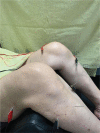Combined effect of laser acupuncture and electroacupuncture in knee osteoarthritis patients: A protocol for a randomized controlled trial
- PMID: 32195960
- PMCID: PMC7220484
- DOI: 10.1097/MD.0000000000019541
Combined effect of laser acupuncture and electroacupuncture in knee osteoarthritis patients: A protocol for a randomized controlled trial
Abstract
Background: Knee osteoarthritis (KOA) is a common degenerative joint disorder that affects 250 million people globally. KOA can lead to disability and is often associated with cardiovascular disease, poor quality of life, and mortality. The most common treatment for KOA is non-steroidal anti-inflammatory drug administration. However, the analgesic effect is limited and often accompanied by multiple side effects. Hence, many KOA patients opt for complementary and alternative medicine. Acupuncture is one of the most popular complementary treatments with great analgesic effect and minimal side effect. Electroacupuncture (EA) and laser acupuncture (LA) have been known to reduce pain in KOA patients. However, to date, no study has assessed the benefits of combining these two therapies.
Methods: Fifty participants diagnosed with KOA, aged 50 years or older, and with consistent knee pain for more than 3 months were recruited and randomly assigned to the treatment group (EA plus LA) or control group (EA plus sham LA without laser output). All subjects in the treatment group will undergo a combined EA and LA treatment thrice a week for 4 weeks. The acupuncture will be performed on GB33, GB34, SP9, SP10, and ST36 sites. The treatment group will receive acupuncture with a transcutaneous electrical nerve stimulator at GB33, GB34, SP9, and SP10 sites and with LA at EX-LE5, ST35, and BL40 sites. The subjects in the control group will undergo the same treatment modality as the treatment group, except these subjects will not be exposed to laser output. Outcome measurements will include visual analog scale, Western Ontario McMaster Universities Osteoarthritis Index, Knee injury and osteoarthritis outcome, body composition analysis, knee range of motion, quadriceps muscle stiffness, one-leg standing with eyes open test, and the 30-s chair stand test before and after 4 weeks of intervention.
Objectives: This protocol aims to investigate the combined effect of EA and LA in KOA patients.
Conflict of interest statement
The authors have no conflicts of interests to disclose.
Figures




References
-
- Palazzo C, Nguyen C, Lefevre-Colau MM, et al. Risk factors and burden of osteoarthritis. Ann Phys Rehabil Med 2016;59:134–8. - PubMed
-
- Lee BJ, Yang S, Kwon S, et al. Association between metabolic syndrome and knee osteoarthritis: a cross-sectional nationwide survey study. J Rehabil Med 2019;51:464–70. - PubMed
-
- Jinks C, Jordan K, Ong BN, et al. A brief screening tool for knee pain in primary care (KNEST). 2. Results from a survey in the general population aged 50 and over. Rheumatology (Oxford) 2004;43:55–61. - PubMed
Publication types
MeSH terms
LinkOut - more resources
Full Text Sources
Medical

